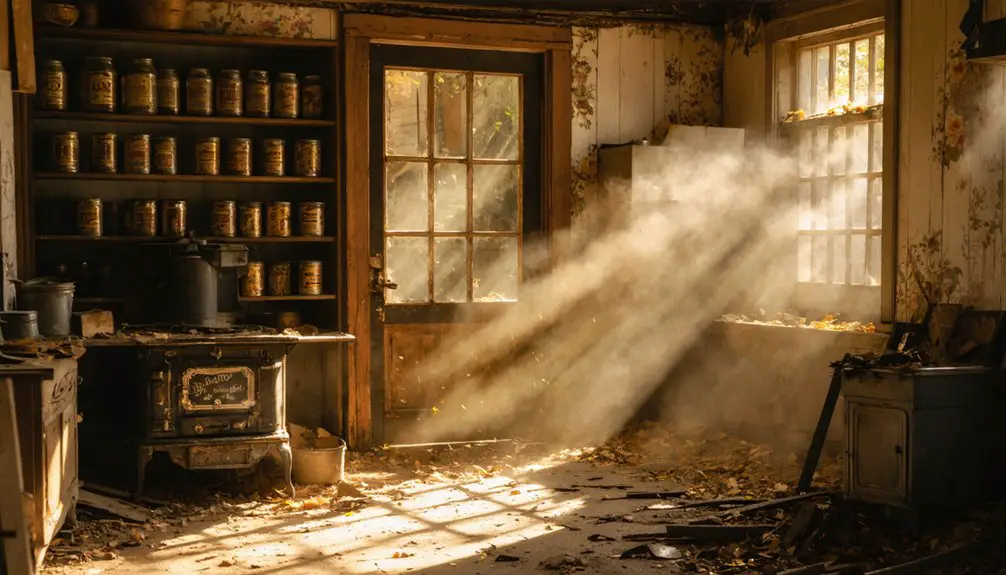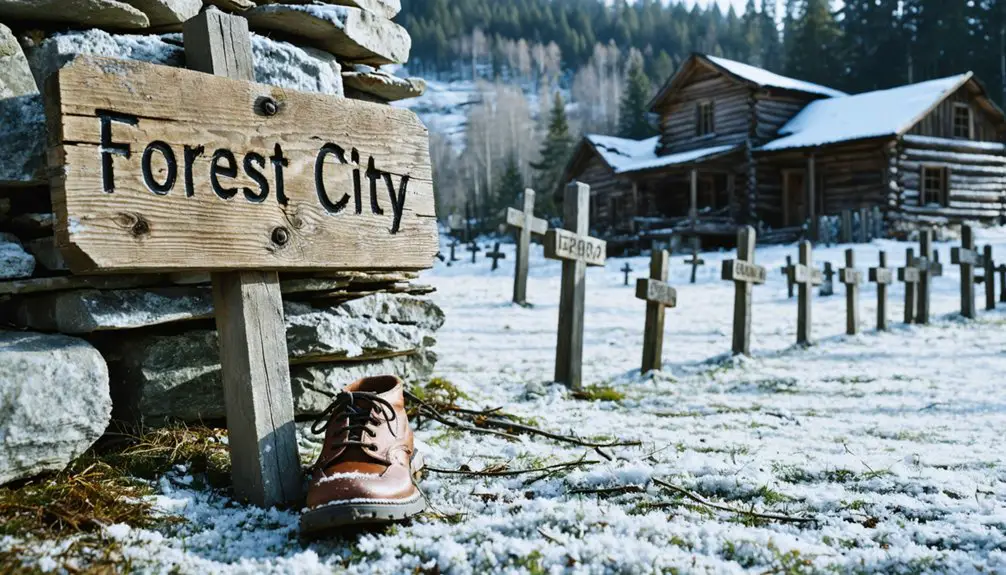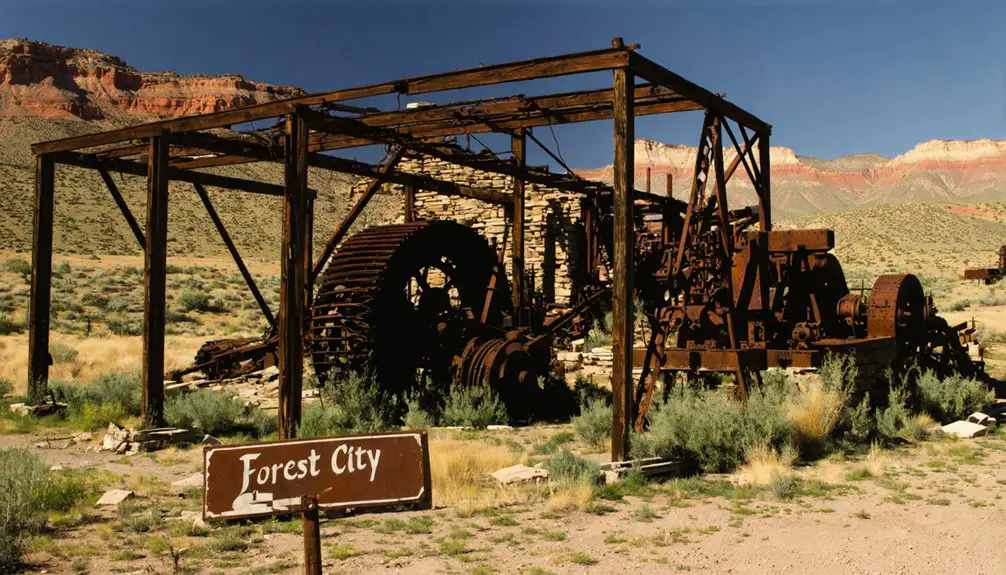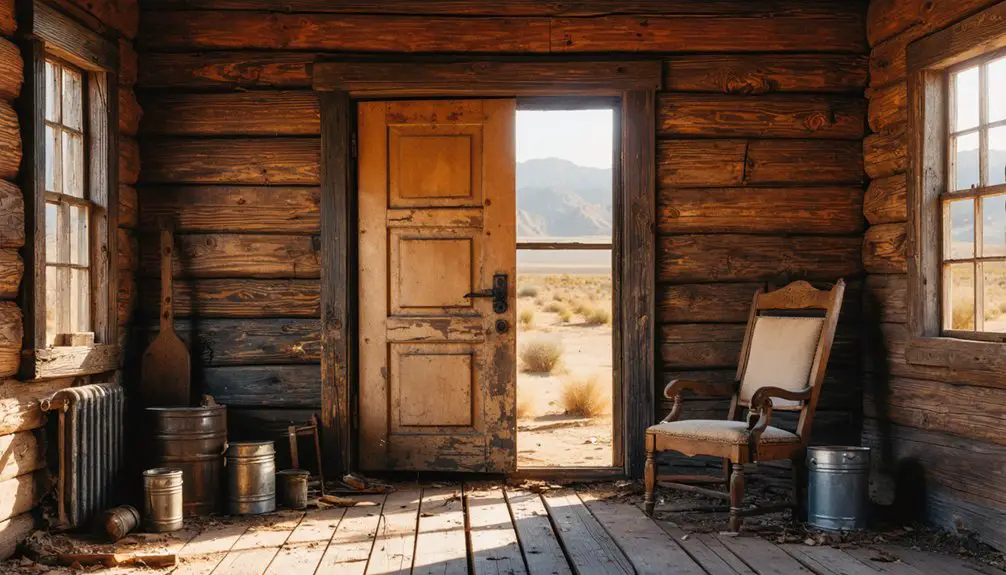You’ll find Forest City tucked away in Utah’s American Fork Canyon, where silver discoveries in 1870 transformed a mountain valley into a bustling mining settlement. The town exploded from 500 to 3,000 residents as the Miller Hill Mine and Sultana Smelting Works drove the local economy. By 1880, depleted ore and transportation challenges had turned this thriving community into a ghost town. Today, scattered ruins and the preserved cemetery at Graveyard Flat reveal fascinating glimpses into its dramatic past.
Key Takeaways
- Forest City was a bustling silver mining town in American Fork Canyon, Utah, established in 1870 following discoveries in Little Cottonwood Canyon.
- The town rapidly grew to 3,000 residents during its peak, driven by the success of Miller Hill Mine and Sultana Smelting Works.
- A devastating diphtheria epidemic in 1872, followed by ore depletion in 1874, contributed to the town’s eventual decline.
- By 1880, Forest City became abandoned after the closure of mines, dismantling of the smelter, and failure of railroad infrastructure.
- Today, only scattered ruins, smelter foundations, and the cemetery at Graveyard Flat remain as evidence of Forest City’s mining heritage.
The Birth of a Silver Mining Town
When silver was discovered in Little Cottonwood Canyon during the late 1860s, prospectors quickly expanded their exploration south across the mountain ridge into American Fork Canyon. This silver discovery led to a flurry of mining claims and the official organization of the American Fork Mining District in July 1870.
At the heart of this development was the Miller Hill Mine, which soon emerged as the district’s most productive operation. The mining boom attracted thousands of workers, eventually causing the population to reach 2000 to 3000 residents. The area required careful disambiguation of locations since multiple mining towns shared similar names during this period.
Standing as a beacon of success, the Miller Hill Mine rose to prominence as the region’s leading silver producer.
You’ll find the area’s transformation accelerated in 1871 when New York’s Aspinwall Steamship Company purchased the Miller Hill Mine for $120,000.
They established the impressive Sultana Smelting Works at Dutchman Flat, employing up to 300 workers. Around this industrial hub, Forest City sprang to life, marking the beginning of a significant chapter in Utah’s silver mining history.
Life in the Mountain Valley
As Forest City flourished in the early 1870s, its population swelled from 500 initial settlers to nearly 3,000 residents at the height of mining operations.
You’d find families making their homes in miners’ cabins and company-built houses near the smelter, while children attended the local schoolhouse. The Miller Mining Company invested $90,000 to construct the massive smelting operation.
Despite the mountain challenges of narrow, rocky roads with hairpin turns, you could rely on stagecoach service and two general stores for essential supplies. The town’s location in American Fork Canyon made transportation particularly difficult.
The valley resources proved crucial, with a dairy farm providing fresh milk and butter, while a sawmill and 25 charcoal kilns supported the community’s needs.
Life wasn’t without its hardships – the winter of 1872 brought a devastating diphtheria epidemic that claimed eleven children, who now rest at Graveyard Flat, a solemn reminder of the town’s struggles.
Mining Operations and Economic Boom
Following Johnston’s Army‘s initial discoveries in the early 1860s and the Miller brothers’ subsequent finds in 1870, prospectors flooded American Fork Canyon in search of gold, silver, and lead deposits.
You’d have witnessed a surge in mining techniques as hundreds staked their claims, leading to the formation of the American Fork Mining District to manage operations.
The area’s economic boom peaked when the Aspinwall Steamship Company purchased the Miller Hill Mine for $120,000.
Mining operations expanded rapidly with the construction of the Sultana Smelting Works, employing hundreds.
The Sultana Smelting Works transformed local mining from individual claims into an industrial operation, providing steady work throughout American Fork Canyon.
Despite economic challenges in transporting ore, the region produced over $7 million in precious metals through 1920.
The boom supported Forest City’s growth, complete with sawmills, stores, and even a school, though prosperity wouldn’t last as rich ore veins became depleted.
By the late 1870s, custom mills emerged to process the increasing volume of ore from the surrounding mines.
Railroad Struggles and Transportation Woes
If you’re studying Forest City’s demise, you’ll find the American Fork Railroad‘s battle against geography was lost before it began.
The railroad’s incorporation in 1872 faced immediate challenges with terrain too steep for locomotives in the final four-mile stretch to Forest City, forcing a compromise endpoint at Deer Creek. The railroad’s steep grade rates of up to 296 feet per mile made operations extremely difficult.
The initial Mason steam locomotive proved unsuitable for the challenging terrain, leading to reliance on horse and mule power.
You can trace how this engineering limitation, combined with severe winters and the need to use horses for uphill transport, created an unsustainable operation that became Utah’s first railroad failure by 1878.
Engineering Against Geography
While the American Fork Railroad promised to revolutionize mining transport in Forest City, Utah, the region’s unforgiving geography proved an insurmountable challenge.
The engineering challenges were staggering: you’d find sixteen bridges spanning just five miles of the American Fork River’s unpredictable meanders. The route’s grade reached a punishing 200 feet per mile, making it one of America’s steepest railroads.
Geographic limitations ultimately forced engineers to stop the tracks at Deer Creek, as the final four-mile stretch to Forest City proved too steep for trains to climb.
Even the 14-ton locomotive couldn’t handle the grade, requiring horses and mules to haul empty cars uphill. The brutal terrain left workers relying on gravity braking for downhill loads, while seasonal weather shutdowns further crippled operations.
Doomed From The Start
The American Fork Railroad’s troubles extended far beyond its geographic constraints, revealing fundamental flaws in its conception and execution.
You’ll find that despite early railroad collaboration with Utah Southern, the narrow gauge choice severely limited freight capacity and connections to major markets. The line’s operational limitations became painfully apparent when their lightweight Mason locomotive proved inadequate for mountain hauling, forcing them to rely on horse and mule power for uphill transport.
The railroad’s inefficiencies created a devastating ripple effect. You couldn’t sustainably operate a railroad that required costly mixed animal and mechanical power while struggling with weather shutdowns and crude gravity-controlled descents.
When the railroad failed in 1878, it took Forest City’s future with it, leading to the settlement’s rapid depopulation by 1880.
Daily Life and Community Infrastructure

You’d find Forest City’s essential services concentrated around two general stores and a popular saloon that served as the bustling social center for the mining community.
The town’s commitment to education was evident in its established schoolhouse, which served the children of miners and their families during the settlement’s peak population of 2,000-3,000 residents.
Despite the harsh frontier conditions, the community maintained crucial infrastructure including a dairy farm for food supplies, charcoal kilns for industrial needs, and a sawmill that supported ongoing construction projects.
Essential Local Services
Despite its brief existence as a mining settlement, Forest City’s essential services remained rudimentary and largely focused on supporting mining operations rather than building lasting infrastructure.
You’d find no formal health services, leaving miners to rely on informal medical care from fellow workers or visiting doctors. Communication challenges were inevitable given the town’s remote location and lack of documented telegraph or postal services.
The town’s lifeblood – its smelter and attempted railroad connection – ultimately proved insufficient to sustain long-term development.
You’ll find that access to basic necessities depended on costly wagon transport after the railroad project failed. Natural water sources from American Fork Canyon served both industrial and residential needs, but without modern utilities or safety infrastructure, the harsh mountain environment remained a constant challenge for residents.
Social Life and Recreation
While Forest City’s population peaked at roughly 2,000-3,000 residents, daily social life centered primarily around practical gathering spots like the town’s saloons, general stores, and hotels.
You’d find workers congregating at these establishments after their shifts, sharing news and strengthening community bonds through informal socializing.
Without formal recreational facilities, you’d need to make your own entertainment. Community gatherings often emerged from shared challenges, particularly during harsh winters and disease outbreaks.
The town’s cemetery at Graveyard Flat became a reflection of these collective hardships. While the railroad eventually brought sightseeing visitors up the canyon, most recreational activities remained simple and closely tied to daily survival.
You might spend your free time exploring the natural surroundings or joining fellow residents at the saloon, which served as the town’s primary social hub. Similar to Silver Reef’s thriving period, the town supported multiple businesses and services that contributed to its social fabric.
Frontier Education Provisions
Beyond the saloons and social gatherings, Forest City’s commitment to education manifested in a simple yet purposeful schoolhouse that served the area’s children.
You’d find this frontier schooling center positioned strategically near the blacksmith shop and community furnaces, making it accessible to local families.
Inside the wooden structure, you’ll discover the foundations of community education where reading, writing, and arithmetic formed the core curriculum.
The one-room schoolhouse accommodated multiple age groups, with local teachers – often settlers themselves – adapting to fluctuating attendance.
They’d work with limited resources, using basic wooden furniture and relying on natural light through windows.
Mormon traditions influenced the educational approach, combining practical skills with religious instruction to prepare children for the rugged frontier environment.
Like many frontier schools that faced natural disasters, the building suffered damage from the 1902 earthquake that ultimately impacted the region’s education system.
Similar to Grafton’s school, which closed when enrollment dropped to just nine students, the fate of many frontier educational institutions was tied directly to population changes.
The Diphtheria Epidemic of 1872

A devastating diphtheria epidemic struck Forest City during the harsh winter of 1872, claiming the lives of at least 11 children and several adults in the remote Utah mining settlement.
The epidemic’s impact on the small population of 500 was profound, with victims buried in nearby Graveyard Flat cemetery. With no local doctor and limited access to medical care, the isolated community struggled against the disease while severe weather conditions forced mining operations to shut down.
Despite this tragedy, Forest City showed remarkable community resilience. The town’s population later grew to between 2,000 and 3,000 residents.
Forest City’s endurance prevailed, with its population quadrupling to 3,000 despite the devastating epidemic’s toll.
Today, Graveyard Flat stands as a somber reminder of those lost, though its unmarked graves have suffered from neglect and damage by recreational visitors over the years.
Peak Population and Social Dynamics
Despite surviving the diphtheria epidemic, Forest City’s true peak population remains a subject of historical debate.
Population estimates range dramatically from 150 to 3,000 residents during the town’s brief existence between 1871 and 1880.
You’ll find evidence of real community cohesion through several established institutions that paint a picture of daily life:
- A functioning school served the children of permanent settler families
- A local dairy farm provided fresh milk and butter to residents
- Twenty-five charcoal kilns operated between Forest City and nearby Deer Creek
- A silver smelter formed the economic and social hub of the settlement
The presence of these varied operations, along with the mix of miners, farmers, and skilled workers, suggests a more substantial settlement than the lowest estimates would indicate.
The Fall of Forest City

As you explore Forest City’s decline between 1874-1876, you’ll find the mines’ high-grade silver ore became exhausted while the American Fork Railroad struggled with the canyon’s challenging terrain.
The Sultana Smelter’s dismantling in 1876, coupled with the railroad’s closure in 1878, made ore transportation costs prohibitively expensive for the remaining mining operations.
These economic pressures triggered a rapid exodus of residents, and by 1880, Forest City had transformed from a bustling mining settlement into an abandoned ghost town.
Mining Operations Cease
While Forest City initially thrived from its rich mineral deposits, the mining operations that fueled its growth began to falter by 1874 when the Miller Hill Mine, the town’s primary ore producer, ceased regular production.
Despite advanced mining technology for its time, the area’s resource depletion proved insurmountable. You’ll find the decline happened swiftly:
- The Sultana Smelter, which had employed 250-300 men, was dismantled by 1876 as ore processing became unsustainable.
- Transportation challenges and incomplete railroad infrastructure crippled efficient ore shipment.
- Mining production peaked briefly during World War I but couldn’t maintain momentum.
- By the 1940s, all mining operations had completely ceased, unable to compete with larger Utah mining districts like Bingham and Park City.
The once-bustling mining town couldn’t survive these compounding setbacks, leading to its eventual abandonment.
Transportation Costs Doom City
The failure to complete critical railroad infrastructure sealed Forest City’s fate in the late 1870s.
When engineers couldn’t extend the American Fork Railroad beyond Deer Creek due to the steep terrain, you’d have seen wagons struggling to transport ore and bullion over the final four miles to the railhead.
These transportation inefficiencies created a devastating ripple effect throughout the mining community.
As costs skyrocketed, profit margins vanished. You couldn’t sustain mining operations when moving materials became prohibitively expensive.
The economic collapse hit hard and fast – the smelter shut down, mines closed, and residents fled.
Population Rapidly Disperses
Multiple crises struck Forest City in rapid succession during the 1870s, starting with a devastating diphtheria epidemic in 1872 that claimed eleven children’s lives.
The population dynamics shifted dramatically as the town’s foundation crumbled beneath its residents’ feet.
You’ll understand the community fragmentation through these vital developments:
- The harsh winter of 1872 forced mining operations to shut down, leaving workers idle.
- Miller Hill Mine’s closure in 1874 marked the beginning of widespread unemployment.
- The Sultana Smelter’s dismantling in 1876 eliminated the town’s industrial heart.
- The American Fork Railroad’s 1878 failure sealed the town’s fate.
Remnants and Modern-Day Discoveries
Today, scattered remnants of Forest City’s mining heritage dot Dutchman Flat within American Fork Canyon, including original smelter foundations and weathered house ruins from the 1871-1880 silver mining settlement.
Faded traces of Forest City’s silver mining past linger at Dutchman Flat, where crumbling foundations tell stories of 1870s frontier life.
You’ll find archaeological insights into 19th-century ore processing at the smelter site, while historical photographs and local archives reveal the town’s physical layout and social characteristics.
The cemetery at Graveyard Flat stands as the most preserved feature, though it’s faced challenges from recreational vehicles.
In 2012, Forest Service workers rebuilt the fence and added interpretive signs.
You won’t find official markers leading to the town or cemetery, so you’ll need to navigate the narrow, cliff-hugging roads using local knowledge.
Modern preservation efforts focus primarily on protecting these remaining structures while managing increased recreational traffic in the area.
Preserving a Mountain Mining Legacy
Preserving Forest City’s mining legacy involves four key initiatives: protecting physical remnants, documenting historical records, maintaining the Graveyard Flat cemetery, and addressing environmental impacts.
The cultural impact of this once-thriving mining town lives on through dedicated preservation efforts.
- You’ll find remnants of 19th-century mining technology in the smelter foundations and old house sites scattered throughout American Fork Canyon.
- The cemetery at Graveyard Flat received renewed protection in 2012 when Forest Service teams installed sturdy fencing and signage.
- Local volunteer groups actively maintain historical sites, ensuring the mining heritage remains accessible.
- Environmental remediation efforts address lead contamination under Clean Water Act guidelines while preserving historical significance.
These preservation initiatives help you connect with Forest City’s remarkable story of frontier industrialization and community resilience in Utah’s challenging mountain terrain.
Frequently Asked Questions
What Dangerous Wildlife Existed in Forest City During Its Peak Years?
You’d have faced mountain lions, black bears (not grizzlies), wolves, coyotes, and rattlesnakes. Dangerous insects like black widows and disease-carrying ticks also threatened your survival in these mountains.
How Did Winters Affect Daily Survival in Forest City?
You’d face brutal winter survival challenges, battling constant avalanche threats, diphtheria outbreaks, and food scarcity. You’d need to stockpile supplies, seek shelter among pine trees, and ration resources to stay alive.
What Native American Tribes Originally Inhabited the Dutchman Flat Area?
You’ll find the Ute Tribe dominated Dutchman Flat, while Shoshone culture influenced the northern edges. The Goshute people also maintained a strong presence in this western Utah territory before European settlement.
Were There Any Notable Gunfights or Lawless Incidents in Forest City?
You won’t find documented evidence of notable gunfights or history of lawless behavior here. Historical records show this mining town struggled with economic hardships rather than violence or social disorder.
Did Any Famous Historical Figures Ever Visit Forest City?
You won’t find evidence of any famous historical visitors to this mining settlement. While regional mining entrepreneurs likely passed through, there’s no documentation of notable historical figures spending time here.
References
- https://en.wikipedia.org/wiki/Forest_City
- https://www.lehi-ut.gov/wp-content/uploads/2012/08/ForestCityandtheTragedyatAmericanForkCanyonbyChaseMurphy.pdf
- http://ghosttowntour.blogspot.com/2014/06/forest-city-utah-county-part-1.html
- https://kids.kiddle.co/Forest_City
- https://highlandut.gov/484/Mining
- https://www.youtube.com/watch?v=IwI2R7TMWLA
- https://historytogo.utah.gov/silver/
- https://utahrails.net/mining/little-cottonwood-mines.php
- https://onlineutah.us/forestcity_history.shtml
- https://historytogo.utah.gov/mining/



